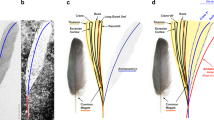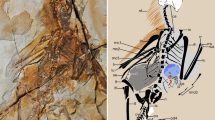Abstract
Discoveries of bird-like theropod dinosaurs and basal avialans in recent decades have helped to put the iconic ‘Urvogel’ Archaeopteryx1 into context2,3,4,5,6 and have yielded important new data on the origin and early evolution of feathers7. However, the biological context under which pennaceous feathers evolved is still debated. Here we describe a new specimen of Archaeopteryx with extensive feather preservation, not only on the wings and tail, but also on the body and legs. The new specimen shows that the entire body was covered in pennaceous feathers, and that the hindlimbs had long, symmetrical feathers along the tibiotarsus but short feathers on the tarsometatarsus. Furthermore, the wing plumage demonstrates that several recent interpretations8,9 are problematic. An analysis of the phylogenetic distribution of pennaceous feathers on the tail, hindlimb and arms of advanced maniraptorans and basal avialans strongly indicates that these structures evolved in a functional context other than flight, most probably in relation to display, as suggested by some previous studies10,11,12. Pennaceous feathers thus represented an exaptation and were later, in several lineages and following different patterns, recruited for aerodynamic functions. This indicates that the origin of flight in avialans was more complex than previously thought and might have involved several convergent achievements of aerial abilities.
This is a preview of subscription content, access via your institution
Access options
Subscribe to this journal
Receive 51 print issues and online access
$199.00 per year
only $3.90 per issue
Buy this article
- Purchase on Springer Link
- Instant access to full article PDF
Prices may be subject to local taxes which are calculated during checkout



Similar content being viewed by others
References
Wellnhofer, P. Archaeopteryx. Der Urvogel von Solnhofen (Dr Friedrich Pfeil, 2008)
Ji, Q., Currie, P. J., Norell, M. A. & Ji, S. Two feathered dinosaurs from northeastern China. Nature 393, 753–761 (1998)
Xu, X. et al. Four-winged dinosaurs from China. Nature 421, 335–340 (2003)
Hu, D., Hou, L., Zhang, L. & Xu, X. A pre-Archaeopteryx troodontid theropod from China with long feathers on the metatarsus. Nature 461, 640–643 (2009)
Xu, X., You, H., Du, K. & Han, F. An Archaeopteryx-like theropod from China and the origin of Avialae. Nature 475, 465–470 (2011)
Godefroit, P. et al. A Jurassic avialan dinosaur from China resolves the early phylogenetic history of birds. Nature 498, 359–362 (2013)
Prum, R. O. & Brush, A. H. The evolutionary origin and diversification of feathers. Q. Rev. Biol. 77, 261–295 (2002)
Nudds, R. L. & Dyke, G. J. Narrow primary feathers rachises in Confuciusornis and Archaeopteryx suggest poor flight ability. Science 328, 887–889 (2010)
Longrich, N. R., Vinther, J., Meng, Q., Li, Q. & Russell, A. P. Primitive wing feather arrangement in Archaeopteryx lithographica and Anchiornis huxleyi. Curr. Biol. 22, 1–6 (2012)
Xu, X. & Guo, Y. The origin and early evolution of feathers: insights from recent paleontological and neontological data. Vertebrata PalAsiatica 47, 311–329 (2009)
Li, Q. et al. Plumage color patterns of an extinct dinosaur. Science 327, 1369–1372 (2010)
Li, Q. et al. Reconstruction of Microraptor and the evolution of iridescent plumage. Science 335, 1215–1219 (2012)
Longrich, N. R. Structure and function of hindlimb feathers in Archaeopteryx lithographica. Paleobiology 32, 417–431 (2006)
Turner, A. H., Makovicky, P. J. & Norell, M. A. A review of dromaeosaurid systematics and paravian phylogeny. Bull. Am. Mus. Nat. Hist. 371, 1–206 (2012)
Zheng, X. et al. Hind wings in basal birds and the evolution of leg feathers. Science 339, 1309–1312 (2013)
Lucas, A. M. & Stettenheim, P. R. Avian Anatomy. Integument, Parts I and II 197–233 (U.S. Government Printing Office, 1972)
Gatesy, S. M. & Dial, K. P. From frond to fan: Archaeopteryx and the evolution of short-tailed birds. Evolution 50, 2037–2048 (1996)
Meseguer, J. et al. Lift devices in the flight of Archaeopteryx. Span. J. Palaeontol. 27, 125–130 (2012)
Foth, C. On the identification of feather structures in stem-line representatives of birds: evidence from fossils and actuopalaeontology. Paläontol. Z. 86, 91–102 (2012)
Xu, X., Zheng, X. & You, H. Exceptional dinosaur fossils show ontogenetic development of early feathers. Nature 464, 1338–1341 (2010)
Nachtigall, W. & Kempf, B. Vergleichende Untersuchungen zur flugbiologischen Funktion des Daumenfittichs (Alula spuria) bei Vögeln. Z. Vgl. Physiol. 71, 326–341 (1971)
Chiappe, L. M. & Dyke, G. J. The Mesozoic radiation of birds. Annu. Rev. Ecol. Syst. 33, 91–124 (2002)
Ji, Q., Norell, M. A., Gao, K., Ji, S. & Ren, D. The distribution of integumentary structures in a feathered dinosaur. Nature 410, 1084–1088 (2001)
Xu, X. & Zhang, F. A new maniraptoran dinosaur from China with long feathers on the metatarsus. Naturwissenschaften 92, 173–177 (2005)
O’Connor, J. et al. Unique caudal plumage of Jeholornis and complex tail evolution in early birds. Proc. Natl Acad. Sci. USA 110, 17404–17408 (2013)
Ji, Q. et al. First avialian bird from China. Geol. Bull. China 24, 197–210 (2005)
Godefroit, P. et al. Reduced plumage and flight ability of a new Jurassic paravian theropod from China. Nature Commun. 4, 1–6 (2013)
Chiappe, L. M., Marugán-Lobón, J., Ji, S. & Zhou, Z. Life history of a basal bird: morphometrics of the Early Cretaceous Confuciusornis. Biol. Lett. 4, 719–723 (2008)
O’Connor, J. K., Chiappe, L. M., Chuong, C., Bottjer, D. J. & You, H. Homology and potential cellular and molecular mechanisms for the development of unique feather morphologies in early birds. Geosciences 2, 157–177 (2012)
Chiappe, L. M. et al. A new specimen of the Early Cretaceous bird Hongshanornis longicresta: insights into the aerodynamics and diet of a basal ornithuromorph. PeerJ 2, e234 (2014)
Acknowledgements
We thank B. Pohl for making the specimen available for study, C. Keilmann and R. Albersdörfer for assistance, Xu X. for access to material, and R. Carney, G. Mayr and A. López-Arbarello for discussions. This study was supported by the Volkswagen Foundation under grant I/84 640 (to O.W.M.R.).
Author information
Authors and Affiliations
Contributions
C.F. and O.W.M.R. designed the study, collected and analysed the data and wrote the paper; H.T. did all the photography and helped with discussions.
Corresponding author
Ethics declarations
Competing interests
The authors declare no competing financial interests.
Additional information
The data matrix for the phylogenetic analysis has been deposited in MorphoBank (http://www.morphobank.org) as project 1126.
Extended data figures and tables
Extended Data Figure 1 The 11th specimen of Archaeopteryx under ultraviolet light.
a, Overview photograph of the 11th skeletal specimen of Archaeopteryx. Scale bar, 5 cm. b, Presacral vertebral column. Scale bar, 2 cm. c, Right forelimb. Scale bar, 5 cm.
Extended Data Figure 2 Anatomical details of the 11th skeletal specimen of Archaeopteryx.
a, Preserved cranial remains under ultraviolet light. Scale bar, 1 cm. b, Enlargement of the tooth row of the left premaxilla in medial view under normal light. c, Pelvis under normal light. Arrow points to the impression of the (broken) ‘intermediate process’ of the ischium. Scale bar, 1 cm. Abbreviations: ar, articular; il, ilium; in, incision in posterior end of jugal; is, ischium; ld, left dentary; lf, left femur; lj, left jugal; lpm, left premaxilla; pu, pubis; qjp, quadratojugal process of the jugal; rd, right dentary; rpm, right premaxilla; sa, surangular; sp, splenial.
Extended Data Figure 3 Overview the plumage in the 11th specimen of Archaeopteryx.
Colour code: yellow, body feathers from different body regions, which cannot be assigned to a certain body region; light blue, heckle feathers; sky blue, body feathers; dark blue, tibial feathers; red, femoral feathers; black, metatarsal feathers; light green, rectrices; green, remiges. Scale bar, 5 cm.
Extended Data Figure 4 Details of the plumage of the 11th specimen of Archaeopteryx.
a, Primary wing feathers under ultraviolet light. b, First and second primary and first secondary wing feathers under ultraviolet light. c, Close up of the primary feathers showing the rhachides and the barbs. d, Close up of the metatarsal feathers. Scale bar, 1 cm.
Extended Data Figure 5 Wing morphology of the 11th specimen of Archaeopteryx in dorsal view.
a, Rhachides of the primaries shown as yellow dashed lines. b, Imprints of the dorsal coverts marked by yellow arrows. Scale bars, 1 cm.
Extended Data Figure 6 The relative rhachis diameter of the primaries of Archaeopteryx and modern birds in relation to body mass.
a, Measurements of primaries of the 11th specimen of Archaeopteryx. b, Plot of the ratio of rhachis diameter to feather length against body weight (both log transformed). Yellow dots represent feathers of the 11th specimen of Archaeopteryx; black dots represent data of modern birds; red rectangles represent data of Confuciusornithidae. See Supplementary Information for details.
Extended Data Figure 7 Phylogenetic hypothesis used for tracing plumage characters.
a, Strict consensus tree of 3,020 most parsimonious trees (tree length = 2,612; consistency index = 0.275; retention index = 0.730). b, Reduced consensus tree of the pruned data matrix after the exclusion of Shenzhousaurus, Segnosaurus, Erliansaurus, Albinykus, Saurornitholestes, Harygryphus, Tianyuraptor, Hesperonychus, Pyroraptor, Lithornis, Liaoningornis and Limneavis.
Supplementary information
Supplementary Information
This file contains Supplementary Text 1-6, Supplementary Tables 1-2, a list of Characters 1-356 and additional References. (PDF 1909 kb)
Rights and permissions
About this article
Cite this article
Foth, C., Tischlinger, H. & Rauhut, O. New specimen of Archaeopteryx provides insights into the evolution of pennaceous feathers. Nature 511, 79–82 (2014). https://doi.org/10.1038/nature13467
Received:
Accepted:
Published:
Issue Date:
DOI: https://doi.org/10.1038/nature13467
This article is cited by
-
Escape behaviors in prey and the evolution of pennaceous plumage in dinosaurs
Scientific Reports (2024)
-
Reinterpretation of purported molting evidence in the Thermopolis Archaeopteryx
Communications Biology (2021)
-
Reply to: Reinterpretation of purported molting evidence in the Thermopolis Archaeopteryx
Communications Biology (2021)
-
Scaling trends of bird’s alular feathers in connection to leading-edge vortex flow over hand-wing
Scientific Reports (2020)
-
Archaeopteryx feather sheaths reveal sequential center-out flight-related molting strategy
Communications Biology (2020)
Comments
By submitting a comment you agree to abide by our Terms and Community Guidelines. If you find something abusive or that does not comply with our terms or guidelines please flag it as inappropriate.



